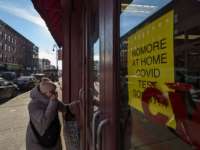
When President Joe Biden was campaigning for office, he said that to beat the coronavirus, the U.S. needed the testing equivalent of President Franklin D. Roosevelt’s War Production Board.
That board had sweeping powers to shift the country’s economy to support the war effort, and it ultimately oversaw a reported 40% of the world’s munition production during World War II.
“It’s how we produced tanks, planes, uniforms, and supplies in record time,” the Biden campaign website said. “And it’s how we can produce and distribute tens of millions of tests.”
The day after his inauguration, Biden signed an executive order creating the Pandemic Testing Board. He said he would be putting the “full force of the federal government” behind expanding testing.
A year later, though, it’s remarkably hard to tell what the board has done.
As far as we can find, the group has put out no press releases, held no hearings and made no announcements. Biden’s executive order states that the head of the board would be, or be chosen by, the White House’s head of COVID-19 response. That’s Jeffrey Zients, but when we contacted him, he didn’t respond.
When we asked White House officials about the Pandemic Testing Board — who was on it and what actions it had taken — they declined to answer our questions and pointed us to the Department of Health and Human Services.
That agency did respond to our inquiries about the board, but its answers offered few details about the board’s work. It did not say who is on the panel or what decisions it has made.
“The Pandemic Testing Board serves as the forum where agencies across the federal government which are involved in testing can describe emerging challenges and what they are learning,” the agency said. “It provides a mechanism for addressing policy and implementation issues regarding the supply and distribution of tests, as well as increasing access to and affordability of tests in the community.”
The agency’s full statement also notes that the board has met regularly and has been split into two groups, one focused on test supply and the other on testing policies.
Public health experts told us they, too, hadn’t heard much about the board.
“I had assumed that they jettisoned these plans,” said Jennifer Nuzzo, an epidemiologist and professor at Johns Hopkins University. “If it still exists, it is certainly very low profile,” said Lawrence Gostin, a professor of global health law at Georgetown University. The country’s first coronavirus testing czar, Adm. Brett Giroir, said he knew little about it as well. “It is rumored to have met, but I did not see public disclosure or reports from the meetings.”
Of course, the inner workings of a board are less important than whether the government is getting the job done. But as ProPublica detailed in November, the Biden administration has been slow to roll out wider testing — just what the board was created to do.
In October, White House officials reportedly disregarded a proposal from testing experts to send rapid tests directly to Americans in anticipation of a COVID-19 spike during the holidays. Press secretary Jen Psaki also infamously dismissed the idea in a December briefing.
Later that month, the Biden administration announced it would send tests directly to Americans. But the tests are arriving just as the omicron wave is receding, and critics have argued that the effort shortchanges communities of color.
“I think it’s damn well about time,” said David Paltiel, a professor of public health at Yale University. “It’s never too late, but some of us have been screaming and yelling about the idea for more than 18 months.”
There was no shortage of money for expanding testing. As part of last year’s stimulus package, Congress appropriated nearly $48 billion for testing, contact tracing and other efforts to prevent the spread of COVID-19. That is in addition to $48 billion set aside for testing in 2020.
But just like with the board’s activities, details about where exactly the money has gone have been hard to come by. Since the Biden administration hadn’t released a breakdown, we submitted a request for specifics more than two months ago.
Sens. Richard Burr, R-N.C., and Roy Blunt, R-Mo., sent a letter on Jan. 3 asking for similar information. After Burr’s office shared what it had learned, the Biden administration sent ProPublica a one-page rundown of COVID-19 spending last week.
The allocations thus far include: $10 billion for testing in schools, $9 billion for manufacturing testing supplies, nearly $5 billion for testing uninsured individuals, and more than $4 billion for testing and mitigation measures for high-risk populations. Nearly $3.9 billion went toward free community testing at pharmacies and federally qualified health centers, and $2.9 billion went to the Centers for Disease Control and Prevention for expanding labs and testing capacity. More than $1.9 billion has gone toward COVID-19 testing of unaccompanied minors at the U.S.-Mexico border. About $3.6 billion is listed as simply “activities previously planned for PPPHCEA,” a reference to the 2020 Paycheck Protection Program and Health Care Enhancement Act. The Indian Health Service received an additional $1.5 billion. Another $4.4 billion is still pending allocation.
Mara Aspinall, an Arizona State University professor and an adviser to the Rockefeller Foundation on the subject of COVID-19 testing, has been tracking HHS press releases to figure out how the stimulus funds have been spent, since the numbers are not publicly disclosed. She said testing should have been more of a focus since the beginning of the pandemic, but there’s still plenty left to do.
“There are a lot of indications that the federal government and state governments are understanding the power of the information that tests bring,” she said. “But what we can’t repeat is the error of last spring thinking it was over and therefore not continuing to focus.”
This post was originally published on Latest – Truthout.